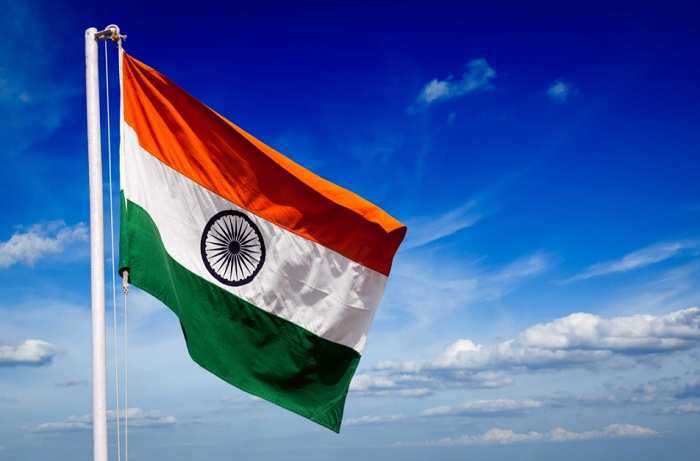On the eve of Independence Day I think we should all know about the History of our Indian Tricolor, for pride and grandiosity of our flag we can sacrifice our life.
"A flag is a necessity for all nation.Millions have died for it.It is no doubt a kind of idolatry which would be a sin to destroy" ~ said by Mahatma Gandhi.
Every free nation of the world has its own flag.It is a symbol of a free country that represent the prosperity of a nation.The National Flag of India was adopted in its present form during the meeting of Constituent Assembly held on 22 July 1947, a few days before India's Independence from the British on 15 August.It is served as the national flag of the Dominion of India between 15 August 1947 and 26 January 1950 and that of the Republic of India thereafter .In India the term " tricolor " refers to the Indian national Flag.
Major Details about Indian Flag
The National Flag of India is a horizontal tricolor of deep saffron(kesari) ar the top , white in the middle and dark green at the bottom in equal proportion. The ration of width of the flag to its length is two to three.In the center of the white band is a navy blue wheel which represents the chakra. Its design is that of the wheel which appears on the Sarnath Lion Capitol of Ashoka and It has 24 spokes.
Evolution of Indian Flag
It is really amazing that our Indian flag see the various changes in it since its first inception.It was discovered or recognised during our national struggle for freedom.The evolution of the Indian National Flag sailed through many vicissitudes to arrive at what it is today.In one through our evolution of our Indian Flag we can observe the political developments in the nation.
Some of the historical milestones in the evolution of our National Flag involve the following :
 |
| Unofficial flag of India in 1906 |
The first national flag in India is said to have been hoisted on August 7 , 1906 in the Parsee Bagan Square(Green Park) in Calcutta now Kolkata. The flag was composed of three horizontal strips of red, yellow and green.
 |
The Berlin committee flag first raised by
Bhikaji Cama in 1907 |
The Second flag was hoisted in Paris by Madame Cama and her band of exiled revolutionaries in 1907.This was very similar to the first one except that the top strip had only one lotus but seven stars denoting the Saptarishi.This flag was also exhibited at a socialist conference in Berlin.
 |
The flag used during the Home Rule movement
in 1917 |
The third flag went up in 1917 when our political struggle had taken a definite turn.Dr.Annie Besant and Lokmanya Tilak hoisted it during the Home rule movement.This flag had five red and four green horizontal strips arranged alternately, with seven stars in the saptrishi configuration super imposed on them.In the left on the top corner was the Union Jack.There was also a white crescent and star in right corner.
 |
The flag unofficial adopted in 1921
|
During the session of the All India Congress which met at Bezwada in 1921 an Andhra Youth prepared a flag and took it to Gandhiji.It was made up two colours red and green representing the two major communities i.e. Hindus and Muslims. Gandhiji suggested the addition of a white strip to represent the remaining communities of India and the spinning wheel to symbolise progress of the Nation.
 |
The flag adopted in 1931.
This flag was also the battle ensign of the
Indian National Army
|
The year 1931 was a landmark in the history of the flag.A resolution was passed adopting a tricolor flag as our national flag.This flag the forbear of the present one , was saffron ,white nad green with Mahatma Gandhi's spinning wheel at the center . It was however clearly stated that it bore no communal significance and was to be interpreted thus.
 |
| The present Tricolor flag of India |
On july 22 , 1947 the Constituent Assembly adopted it as free India National Flag. After the advent of Independence the colours and their significance remained the same.Only the Dharma Chakra of Emperor Asoka was adopted in place of the spinning wheel as the emblem on the Flag.Thus the tricolor flag of the Congress party eventually became the tricolor flag of the Independent India.
Significance of Three colours of Indian flag
In the national flag of India the top band is saffron colour , indicating the strength and courage of the country.The white indicate peace and truth with Dharma chakra.The last vand inidcates the fertility , growth and auspiciousness of the land.
On 26th January 2002 , the Indian flag code was modified and after several years of independence the citizens of India were finally allowed to hoist the India flag over their homes,offices and factories on any day and not just National days as was the case earlier.
I hope you learn a lot from here about the evolution of Indian flag we can say that our national flag in past shows the history of politics in India.
JAI HIND
VANDE MATRAM













0 Comments